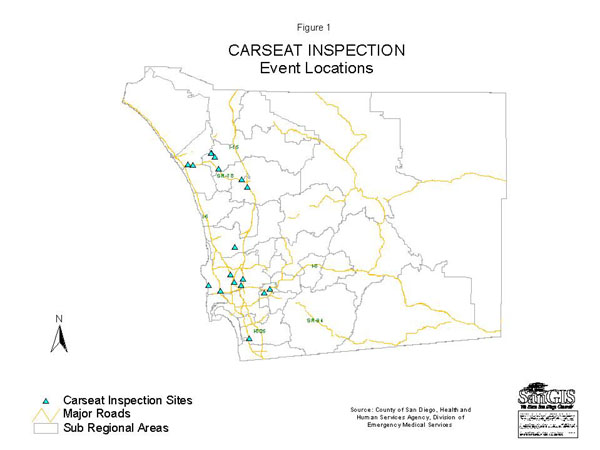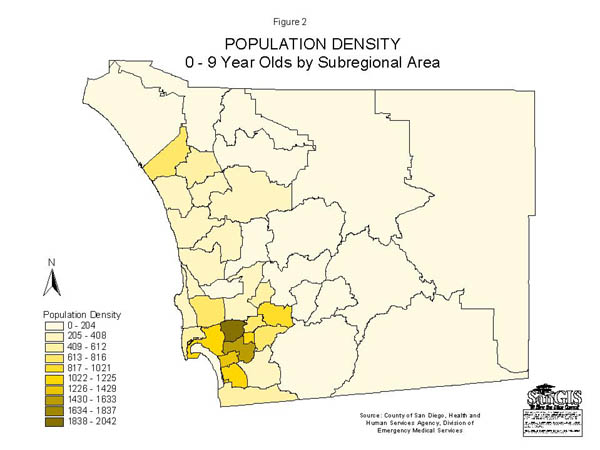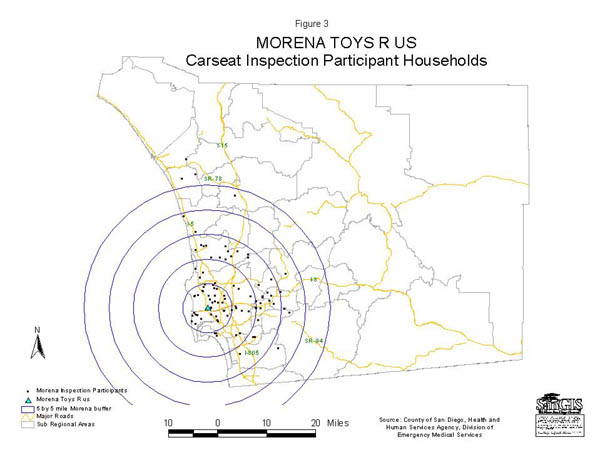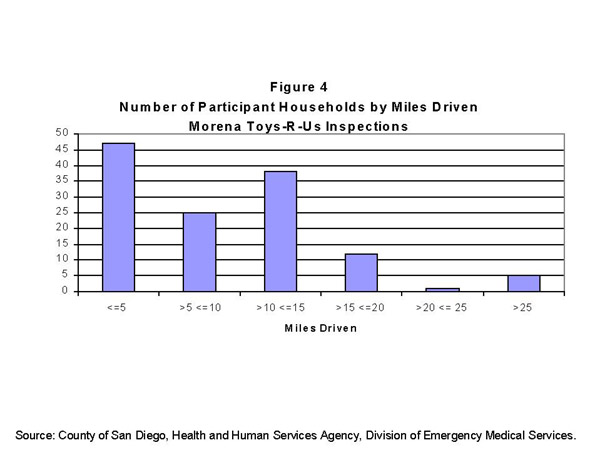Barbara M. Stepanski, MPH; Leslie Upledger Ray, MA, MPPA; Dale L. Cooper; Patti Akers, MA; Louise Nichols; Roxanne Hoffman; David Thompson
This investigation of demographic characteristics of participants in infant/child car seat inspections demonstrates a practical application of ArcView GIS and spatial analysis into Injury Surveillance and Prevention. An overlay of demographic and economic estimates and residency of participants were analyzed to determine distinctiveness of the population involved in past inspections. With this information, investigators are able to focus on identifying populations not represented, community outreach to increase awareness and to strategically plan future inspection locations.
The National Highway Traffic Safety Administration NHTSA has estimated that 97% of infants (birth to one year old) are now traveling in safety seats, an increase of 12% from 1996. Similarly, the use of toddler safety seats (for one to four years olds) has increased to 91%, up 31% from 1996. Even though this is encouraging, all too often the appropriate restraint for the age, size, or developmental stage of the child is not used. It has been estimated that 80 to 90% of children are incorrectly restrained in motor vehicles. In addition, parents and caregivers do not use the full range of age appropriate restraint systems from rear facing to booster seats. The public needs to understand that vehicle safety belts do not properly protect an individual until they are 4'9"tall and weigh approximately 80lbs. A secure fit of the vehicle belt system is achieved when the lap portion of the belt rides low on the hips while the shoulder belt is positioned over the sternum. The perception that children 4 years and older are "safe" restrained vehicle safety belts needs to change. This inappropriately restrained population is at high risk for injury and death in motor vehicle crashes.
In the County of San Diego, of the children ages 0-9 seen by Paramedics/Emergency Medical Technicians (EMTs), 8% were seen for injuries sustained in motor vehicle crashes (MVC). Among these, 50% of the 0-4 year olds were not restrained in child safety seats and 11% were completely unrestrained at the time of the crash. Among the 5-9 year olds, 20% were completely unrestrained.
A significant contributing factor to the increased use of child safety restraints has been legislation. Almost all states have primary enforcement laws allowing police officers to stop and ticket drivers for broken taillights and throwing trash out of the window of a vehicle. However, only 17 states and the District of Columbia have primary seat belt laws. Beginning in January 2002 in California the child safety restraint law will extend to children up to age 6 or 60 lbs.
Local efforts by Buckle-Up San Diego and the San Diego Safe Kids Coalition have aimed to remedy this situation by inspecting child restraints and educating parents on their proper installation and use. Over the past few years theses organizations have held child car seat inspections throughout the County of San Diego. Data collected at these inspections were analyzed by the County of San Diego Heath and Human Services Agency, Division of Emergency Medical Services. Beyond the analysis of installation and misuse, a spatial analysis was done in order to assist these agencies in identifying the population already attending their inspections and plan for future events.
Data from 41 infant/child restraint inspection events held throughout the County of San Diego during 1999-2001 were analyzed. These events occurred at various locations such as retail stores, health fairs, schools, and churches. Each event was staffed by a team of NHTSA trained child passenger safety technicians and senior technicians. Each seat was inspected and evaluated by two technicians to determine whether or not specific criteria for proper installment of the seat type were met. A standardized checklist was used to record demographic, vehicle, and installation and use error information. This data was entered into SPSS (Statistical Package for the Social Sciences) for analysis. Relevant variables were then converted into dBase format to be read into ArcView. Dot maps were produced using car seat inspection location and residency of participants. Most addresses were automatically geocoded using a data matching program developed specifically for this purpose. The remaining addresses were geocoded manually. Child population ages 0-9 per square mile were represented by a Chloropleth map and overlaid with layers showing participant residences and event locations. For purposes of this spatial analysis each child seat inspected was considered a "participant".
These 41 events consisted of 988 intensive inspections for proper installation and use. Of these, 963 had a determined seat type (rear-facing, forward facing, belt positioning boosters, shield boosters, other restraint, or vehicle safety belts). Each seat type had specific criteria for misuse ranging from 3 measures for belt positioning boosters to 15 measures for rear-facing seats. Overall 95.6% of the seat positions checked had at least one error.
Most seat positions inspected were for children under 1 year of age (37.3%). There was a distinct inverse relationship between the number of seats positions checked and the age of the child. Most parents had infants (under 20 lbs.) correctly placed in rear-facing seats. Only 5 instances were noted in which a child was forward-facing and under 20 lbs. However, older children were much more likely to be placed incorrectly in vehicle seat belts. In 27 cases (90% of those with a reported weight), the child was under the recommended vehicle seat belt weight of 80 lbs.
Overall 34 of the possible 41 Subregional Areas (SRA) were represented at the car seat inspection events. Six of the SRAs (Jamul, Pendleton, Pauma, Palomar-Julian, Laguna-Pine Valley, Anza-Borrego) with no representation were from the outlying part of the county. The 7th was the Miramar Armed Force Base. Seven of the nine SRAs in which events were held had the most representation from participants who resided within that SRA. No significant differences were found when SRA median household income and ethnicity were analyzed.
Within 9 SRAs there were 18 different locations in which the 41 events took place. Figure 1 displays the 18 locations of the events. Of these 41 events, thirteen were held in the Oceanside SRA. However, Oceanside reported only 6.6% of the total number of inspections. Oceanside events attracted participants from 11 of the possible 41 SRAs, in which 65% were from Oceanside or a bordering SRA. On the other hand, Kearny Mesa SRA had the second highest number of events (10) and had the highest number of inspections (404). This was 40.9% of all inspections. Kearny Mesa SRA is more centrally located and attracted participants from 28 of the possible 41 SRAs.
Mid-City, Southeast San Diego, and National City SRAs had the most dense 0-9 year old population with 2042, 1592, and 1238 0-9 year olds per square mile, respectively. However, only 55 participants from these SRAs attended events (44 from Mid-City, 10 from Southeast San Diego and 1 from National City). Of these, 65% attended events in the Kearny Mesa SRA, which borders Mid-City. Most importantly, there were no inspections events held within these 3 SRAs. Figure 2. Displays the density of 0-9 year olds per SRA.
For each of the 18 event locations, participant addresses were mapped by ArcView. For example, Figure 3 displays the event location, participant' address, and miles driven to the Kearny Mesa Toys R Us location. For this location the range of miles driven was 0.6 to 31.2. Figure 4 shows the number of participant households and miles driven to attend the Kearny Mesa Toys R Us event. In this case, most (36.7%) households were <= 5 miles from the event location, 19.5% were > 5 and <= 10 miles away and 29.6% were > 10 and <= 15 miles away. Conducting this distance analysis identified the "catchment" area for each of the existing event locations.
It is interesting to note that in one instance a participant traveled the length of the county, from South Bay to Oceanside, to participate in an event.
The public was made aware of these car seat inspections in various ways. For example, announcements at presentations, fliers at previous events, phone calls made to Buckle-Up, and by word-of-mouth. Currently, through a safety seat program sponsored by a local car dealership, TV advertisement is taking place. This will be tracked to evaluate differences in participant numbers and the distance traveled.
Based on population density of 0-9 year olds and the low number of participants who reside in Mid-City, National City, and Southeast San Diego SRAs, investigators recommended that inspection events be planned for these highly populated areas. Since the 0-9 year old population per square mile was low in the 7 non-represented SRAs, investigators recommended an increase in advertisement of events occurring in nearby SRAs.
Based on this data, the "catchment" area was defined as a 15-mile radius from the event location. In other words, it was determined that majority of participants would travel up to 15 miles to attend an event. Therefore it was recommended that the Community Based Organizations (CBO) add more locations as opposed to holding more events at the same location.
Future analysis that will help determine more demographic factors of participants within SRAs include a breakdown of zip code to identify median household income, ethnicity, and education level.
Not only do these car seat inspections reduce the risk of injury and death to young children they help reduce the price society pays for health care and insurance costs. It has been estimated that inpatient hospital costs for unrestrained victims are 50% higher than for restrained victims. Society picks up 85% of those costs, not the individuals involved in the crash. Compared to the 40,000-45,000 births in the County of San Diego annually, the number of car seats inspected over a 2-year period is only protecting a fraction of those children at risk.




Barbara Stepanski, Biostatistician, email bstepahe@co.san-diego.ca.us
County of San Diego, Health and Human Services Agency, Division of Emergency Medical Services, 6255 Mission Gorge Rd, San Diego, CA 92120, phone: 619.285.6429, fax: 619.285.6531